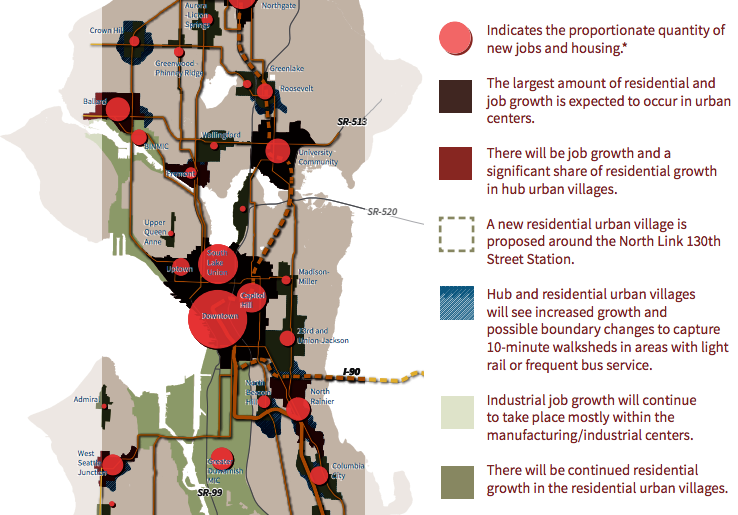For the past two years, the City of Seattle has been hard at work to develop an updated citywide Comprehensive Plan. Seattle 2035, as it is known, takes a broad view on city needs and desires over the next 20 years. Some topics that the plan addresses, includes: parks and open space, transportation, environment, housing and jobs, and land use. Underpinning all of this is the recognition that the city will likely need to accommodate at least 120,000 new residents and 115,000 more jobs by 2035. With this kind of growth on the way, the City will need to provide many more resources to support the anticipated growth. It’s for this reason that we plan.
So far this year, Seattle 2035 has reached two key milestones: the issuance of a Draft Environmental Impact Statement (DEIS) and the release of the Draft Plan. It’s the latter that the City’s wants you to now weigh in. But the two are very different animals. Think of the DEIS as a window into generalized alternatives to accommodate growth in population and jobs. And from that, it’s a way to evaluate tradeoffs and requirements for each alternative to be realized. Meanwhile, the Draft Plan is essentially the full policy document that lays out how the City will execute one preferred alternative. Refinements will be made to the Draft Plan based upon public feedback before a Final Environmental Impact Statement and the subsequent Mayor’s Recommendation Plan are released.
Seattle 2035 itself is based upon the long-standing and successful Urban Village Strategy that the City adopted in 1994. The strategy places an emphasis on focusing most population and job growth within areas of the city with high quality services to support the needs that new development demands while also sustaining the vitality of business and promoting walking, biking, and transit. When Seattle embarked on the Urban Village Strategy, it establish more than two dozen urban villages and urban centers throughout the city. In total, those areas make up about 17% of land within Seattle.
In the new plan, Seattle is slated to add more land to existing urban villages, increase development capacity within them, and even create a brand new urban village. One of the key factors in changes to urban villages is access to high-quality transit services. Areas that are located within a 10-minute walking distance of frequent, high-capacity transit (light rail and bus rapid transit) stops are primary candidates for changes.
Late this summer, the Seattle Department of Planning and Development (DPD) unveiled working draft maps of Seattle’s urban villages and how they might change. Generalized zoning and boundaries of today for each urban village are depicted as well as any potential expansions. At least 10 urban villages could see their boundaries expand, but many urban villages may see no change at all. For instance, the draft map for the Roosevelt/Green Lake Residential Urban Village shows modest boundary expansions south and east while another map depicts fuzzy lines for a new urban village NE 130th St and I-5, the location of a future light rail station. In both cases, the primary driver for urban village expansion is direct access to high-quality transit.
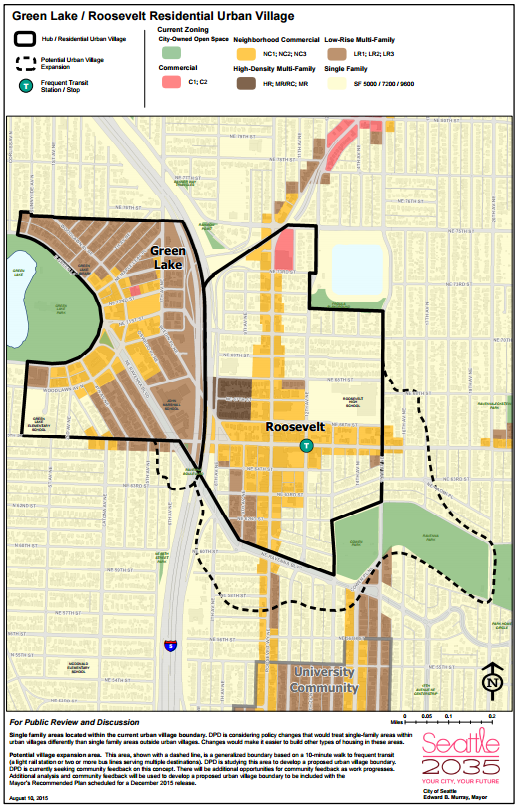
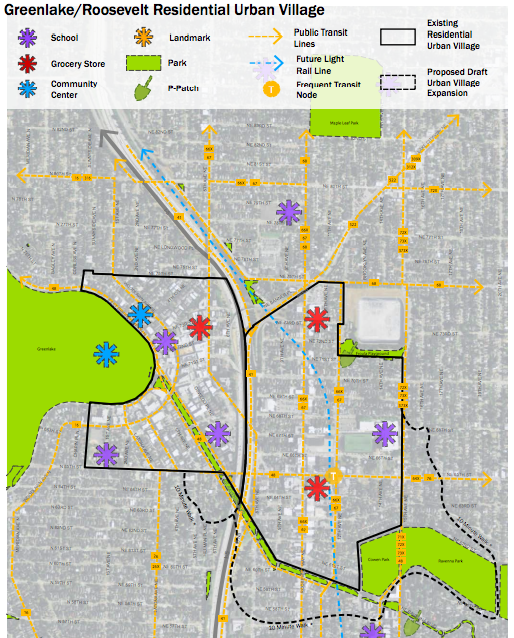

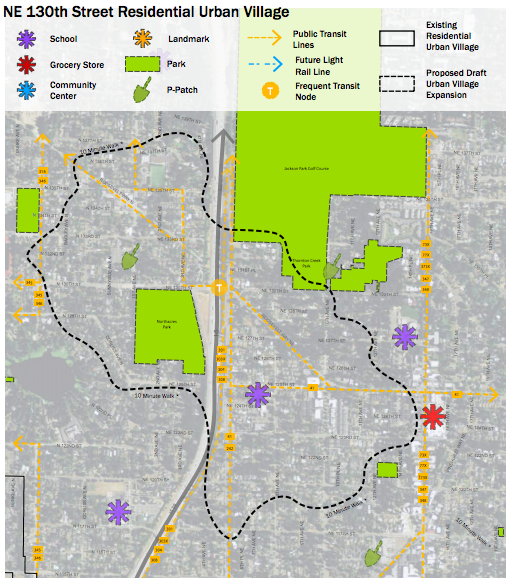
Aside from potential changes to boundaries of urban villages, the Draft Plan also contains hundreds of planning policy modifications. The DPD tries to summarize these into 10 Key Proposals ranging from minimizing displacement of lower income residents to establishing a special Stadium District on the Future Land Use Map. But the extent of the changes is considerably more complex than a few bullet points. Part of the changes come from an overhaul of how the Comprehensive Plan is pieced together, but much of it derives from a real effort to enact substantive changes to support a growing and changing city.
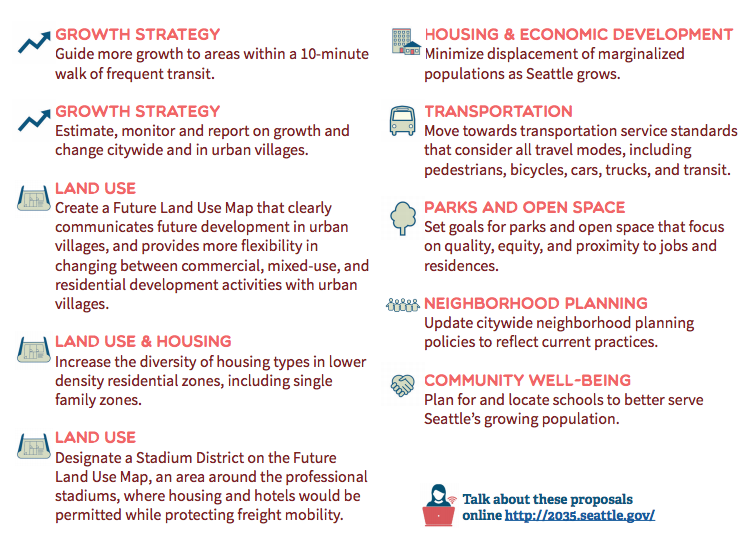
For instance, LUG8 will basically be scraped. Today, the goal reads:
Preserve and protect low-density, single-family neighborhoods that provide opportunities for home-ownership, that are attractive to households with children and other residents, that provide residents with privacy and open spaces immediately accessible to residents, and where the amount of impervious surface can be limited.
But the DPD suggests that it should instead read as:
LU8.2 Use a range of single‐family zones to:
- Maintain the current low height and bulk character of designated single‐family areas
- Protect designated single‐family areas intensity that are predominantly in single‐family residential use, or that have environmental or infrastructure constraints
- Respond to neighborhood plans calling for redevelopment or infill development that maintains the single‐family character of the area but also allows for a greater range of housing types
The change doesn’t mean that the City suddenly lacks concern for children, privacy, open space, or homeownership. But it does mean that those considerations aren’t necessarily directly tied to planning for single-family areas alone. In fact, lest you think the City doesn’t care about homeownership, just jump to H5.22 which explicitly calls for “[s]upport programs that enable Seattle’s extremely low‐ to low‐income homeowners to remain safely and affordably housed.” And not to go unnoticed, the change gives the City more leverage in allowing gentle increases of housing choices within single-family areas.
Happening in parallel to this comprehensive planning process, the City is also engaging in a conversation about housing affordability. The Mayor has put his support behind a collegial set of recommendations from the ad-hoc Housing Affordability and Living Agenda (HALA) Committee, a group of various experts that he commissioned last year. One of the many proposals that HALA endorsed included greater utilization of urban villages through zoned development capacity. A large share of properties within most urban villages consists of single-family zoning. HALA recommended that development capacity should be increased through rezoning of those properties. Both the Mayor and the Seattle City Council have agreed to evaluate this further as the HALA process progresses over the next two years, which could result in up to 6% of single-family properties in the city — all within urban villages — being rezoned.
Get Involved
The DPD is taking the show to the road this month with four opportunities to turn out to public meetings. The first meeting was held yesterday (November 5th) in Ballard with following meetings over the next two weeks in Hillman City, West Seattle, and Licton Springs. Staff will be on hand to answer questions and chat with visitors. Each open house will also have a presentation discussing the Draft Plan, so don’t miss out on that.
Open house dates and locations:
- November 7, 9am to noon (presentation at 10:00 a.m.)
Filipino Community Center (Ballroom)
5740 MLK Jr Way S - November 12, 6pm to 8pm (presentation at 6:30 p.m.)
Senior Center of West Seattle (Hatten Hall)
4217 SW Oregon St - November 14, 9am to noon (presentation at 10:00 a.m.)
North Seattle College (Old Cafeteria)
9600 College Way N.
You can also offer feedback on the proposal through the online open house or by sending an e-mail to the Seattle 2035 team. Public comment on the Draft Plan is open through November 20th. Your feedback at this stage is invaluable as it will guide the Final Environmental Impact Statement and the Mayor’s Recommendation Plan, which is expected to be transmitted to the Seattle City Council in early 2016.
Stephen is a professional urban planner in Puget Sound with a passion for sustainable, livable, and diverse cities. He is especially interested in how policies, regulations, and programs can promote positive outcomes for communities. With stints in great cities like Bellingham and Cork, Stephen currently lives in Seattle. He primarily covers land use and transportation issues and has been with The Urbanist since 2014.

